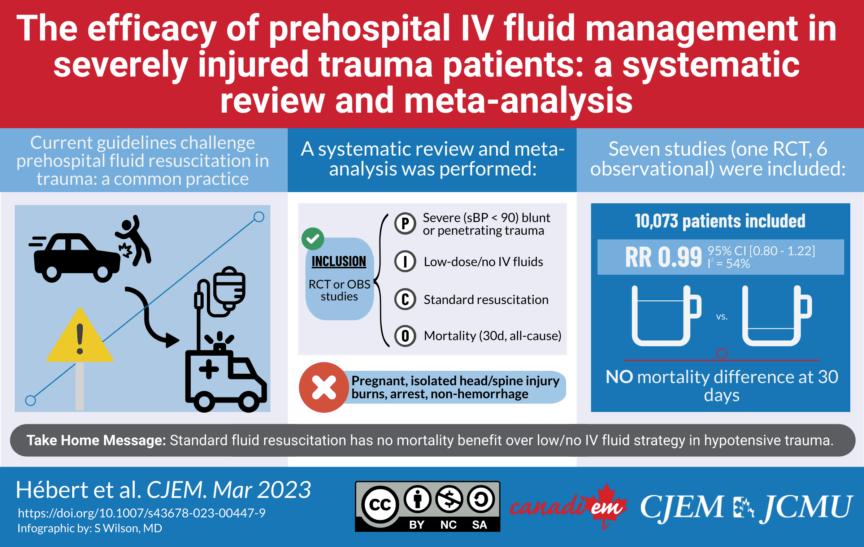We’re back again with another edition of the CJEM: Visual Abstract series. In this collaboration with the Canadian Journal of Emergency Medicine, we select one abstract monthly to highlight with a visual abstract. For March 2023, we selected: “The efficacy of prehospital IV fluid management in severely injured trauma patients: a systematic review and meta-analysis”.1 We hope you enjoy!
Historically, the most widely accepted strategy for the management of hemorrhagic shock or hypotension accompanied by hypotension is fluid resuscitation. In the prehospital setting, isotonic fluids are much more readily available than blood product (the mainstay of management) and are thus most used. Evidence in the last two decades suggests that a restrictive strategy for crystalloid resuscitation may be equivalent, or even beneficial.2–5
Hébert et al. performed a systematic review and meta-analysis to better inform this question. They included randomized or observational studies that included hypotensive trauma patients who received standard crystalloid resuscitation vs low dose/no crystalloid resuscitation. Notable exclusions were patients with pregnancy, isolated head or spinal cord injury, burns, cardiac arrest, or shock not attributable to hemorrhage.
In 10,073 patients studied, the authors found no all-cause mortality difference at 30 days when low dose/no IV fluid strategies were compared to standard resuscitation. While the overall quality of evidence was low, and primarily observational (six of the seven included studies, this review supports questioning the requirement for prehospital IV fluids in trauma. As always, more randomized studies could help to better inform prehospital providers.
Check out the visual abstract below!

- 1.Hébert S, Kohtakangas E, Campbell A, Ohle R. The efficacy of prehospital IV fluid management in severely injured adult trauma patients: a systematic review and meta-analysis. Can J Emerg Med. Published online February 3, 2023:200-208. doi:10.1007/s43678-023-00447-9
- 2.Schreiber MA, Meier EN, Tisherman SA, et al. A controlled resuscitation strategy is feasible and safe in hypotensive trauma patients. Journal of Trauma and Acute Care Surgery. Published online April 2015:687-697. doi:10.1097/ta.0000000000000600
- 3.Bickell WH, Wall MJ Jr, Pepe PE, et al. Immediate versus Delayed Fluid Resuscitation for Hypotensive Patients with Penetrating Torso Injuries. N Engl J Med. Published online October 27, 1994:1105-1109. doi:10.1056/nejm199410273311701
- 4.Duke MD, Guidry C, Guice J, et al. Restrictive fluid resuscitation in combination with damage control resuscitation. Journal of Trauma and Acute Care Surgery. Published online September 2012:674-678. doi:10.1097/ta.0b013e318265ce1f
- 5.Stiell IG, Nesbitt LP, Pickett W, et al. The OPALS Major Trauma Study: impact of advanced life-support on survival and morbidity. Canadian Medical Association Journal. Published online April 22, 2008:1141-1152. doi:10.1503/cmaj.071154


